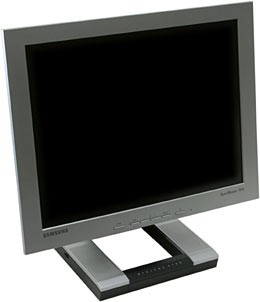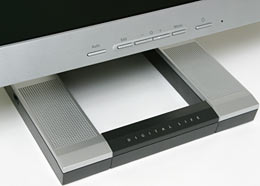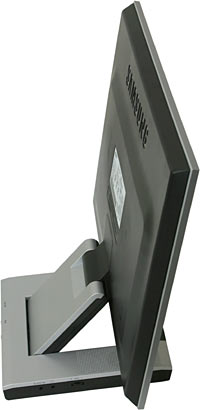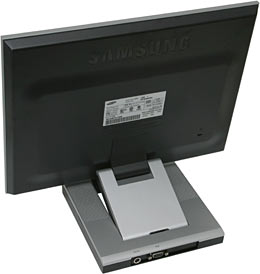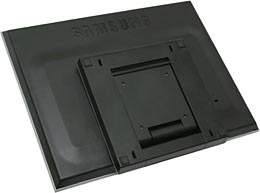
Samsung SyncMaster 152B LCD monitor
Review date: 1 November 2002. Last modified 03-Dec-2011.
LCD (Liquid Crystal Display) monitors are getting better.
They're even becoming a mainstream product, now.
They're still much more expensive than a CRT (Cathode Ray Tube) monitor with a similar display size, but you can get a 15 inch LCD with your entry-level brand-name boring-box for only $US150 more than you'll pay for a basic "17 inch" CRT (actual viewable diagonal 16 inches).
A really nice 15 inch LCD will cost you more, of course, and as the LCDs get bigger the price rises rapidly. Dell will sting you $US1140 to trade your 17 inch CRT for a 20 inch LCD, as I write this. But gone are the days when a miserable little LCD cost a thousand American bucks, and the LCD market was composed entirely of style victims, and people facing serious space or power consumption limits.
Right now, here in Australia, you won't find a decent 15 inch LCD for less than about six Australian dollars per square inch of screen real estate. A 15 inch screen gives you about 108 square inches of viewable area.
15 inch LCDs have more screen area than "15 inch" CRTs, because CRT size specs include about an extra inch of screen that you can't see because it's covered by the plastic surround (it's too curvy for a sharp image to be thrown on it, anyway).
LCDs show you their whole panel, so their size specs are honest; you get the viewable diagonal that's indicated on the box. But a 15 inch LCD still has less than 90% of the screen area of a "17 inch" CRT, and that CRT will cost you from about $AU2.50 to about $AU5.50 per square inch, depending on whether you buy a thoroughly OK medium-range 17 incher, or a flashy big-brand model. The cheaper screens are much better value, if you ask me; Samsung also make some excellent low-cost CRTs.
Here, though, is their SyncMaster 152B. It's a 15 inch 1024 by 768 LCD with a good feature set, and a middling price. Here in Australia, Aus PC Market are selling it for $AU880 including Sydney metropolitan delivery (buyers outside the Sydney metro area will pay more for delivery).
You can get a 15 inch LCD from Aus PC for only $AU660, but the more expensive 152B's got some extra bits to justify its extra price.
First up, and most importantly, it's got a quite nice panel, which looks good - by LCD standards - from a respectable range of angles. Samsung are a major LCD panel manufacturer (many LCD makers buy the actual panels from someone else), and they've put a good panel in this monitor.
Let's have a little talk about that, before we go on to the other trimmings. It's the image quality that's the core feature of any monitor, after all.
One of the things I like least about LCD screens is that they look weird when you view them from different angles. They can't help but be like this, because they've got a sandwich design - the liquid crystals themselves sit between two polarisers. The stack of components that makes up each subpixel (each pixel on an LCD screen is made of three skinny little subpixels, one each for red, green and blue) therefore looks different when it isn't viewed from directly in front.
CRTs don't have this problem, because each glowing phosphor dot on a CRT screen is, functionally, a two dimensional object. It's just a glowing dot on a flat surface, with no depth component, so it looks the same even from quite extreme angles. Because the phosphor's behind some fairly thick glass (if it wasn't, the tube would implode), CRTs still look odd when you're really seriously off-axis. But they beat the heck out of LCDs.
Here, for your eye-candy enjoyment, is a close-up (click it for a larger version) of the 152B screen displaying three overlapping coloured blobs and a Windows pointer. The exposure's been kept down, to stop the dots bleeding into each other. The screen looks quite a lot brighter in real life, but then you can't see the subpixels properly.
A super-close-up of the subpixels in the middle of the colour blobs, showing the way modulation of the brightness of the three subpixels lets the monitor change its pixel colour.
If you want to see black and white LCD pixels close up, there's a shot of the mouse pointer area at the same magnification here.
Yes, I do rather enjoy having a high resolution digital camera with a macro lens. Thank you for asking.
And now, back to the abuse. If you look down on an LCD, it washes out. Look up at it, and it goes dark. You might not think that'd be a problem, as long as you kept your flat panel monitor pointed at your face; who cares about the people trying to read over your shoulder. Unfortunately, LCD computer screens cover enough of your field of vision at normal viewing distances that you actually do end up looking significantly up at the top edge, and significantly down at the bottom edge, when your eyes are lined up with the middle of the screen.
Horizontal viewing angles for LCDs are better, because the tall-and-skinny alignment of the subpixels makes them more even in appearance for viewers to the left and right of the screen.
For the 152B, Samsung quote an 80 degree left and right viewing angle (a hefty 160 degree arc in all), and 70 and 80 degree angles for top and bottom viewing.
At the horizontal extremes, light things go a bit darker and creamier-coloured, while dark things go a bit lighter and reddish. Recent LCDs pretty much have the horizontal-angle thing covered; that's not the problem.
Look down at the 152B from around the outer angle limits and light things go darker and slightly greenish. Look up at it and light things go darker, fuzzier and slightly bluish. Dark things are what really suffer from vertical viewing angle changes on LCDs, though; at normal viewing distances, a "black" screen on the 152B is obviously different shades at the top and the bottom, and well before you get to the vertical angle limits in either direction you'll see substantial lightening of dark shades. This is caused by the backlight's output leaking past the polariser-stacks, and there doesn't seem to be much any LCD manufacturer can do about it.
Light always leaks through an LCD, by the way, no matter what angle you look at it from. A CRT monitor can easily display a black level that's as dark as the monitor would be if you turned it off; all it has to do is not shoot electrons at the phosphor. Easy. LCDs have a backlight that's on all the time, though, and they can never completely stop its light from getting through. This means that the "contrast ratio" of LCD screens - the ratio between the darkest possible black and the lightest possible white - is always lousy compared with CRTs, which can manage a theoretically infinite ratio.
In the real world, this isn't as much of an issue as you'd think, for two reasons. The first reason is that you just get used to having grey-ish blacks. LCD video projectors have even worse contrast ratio problems, but they're not nearly as annoying as you might suppose; you just learn not to notice, about half an hour into the movie. The second reason is that the brighter-lit the room, the more extraneous light will be bouncing off the screen anyway, washing it out. The difference in black level between LCD and CRT is obvious enough in a night-time room lit by a single hundred watt bulb, but during the day it's probably going to be much harder to pick.
Many LCDs aren't the greatest display devices for games, as the pixel response time for a lot of LCDs is slow enough to cause noticeable blurring of high frame rate video. Pretty much any PC LCD monitor on retail shelves today will have no problem dealing with ordinary video frame rates (30 frames per second, at most), but gamers commonly want to see frame rates well over twice that, and pixel response becomes important then.
The response time, which is measured in milliseconds, doesn't translate directly to frame rate - 25ms response time doesn't mean 40 frames per second. Instead, it means 40 full on-to-off transitions per second, for any given subpixel. Smaller transitions - from half-on to full-on, say - actually take longer. Of course, the smaller the transition, the less noticeable blur will be, so it sort of evens out. But given that noticeable blur can happen with a lot less than a full-brightness pixel change, 25ms pixel response still doesn't give you CRT-equivalent frame rate capacity.
The 152B's maximum input refresh rate at 1024 by 768 is 75Hz; LCDs don't have a refresh rate in the CRT sense, so you'll never see any flicker, but the input refresh rate has some bearing on the highest frame rate the monitor can display. It's impossible, in this case, for it to be higher than 75 full frames per second.
Samsung don't quote a pixel response time for the 152B, but it actually seems to be rather good. Not quite up there with CRT, but near enough as is likely to make no difference for those of us whose skillz are not totally 1337. I ran around in 3D games a bit, and was not displeased with the response speed.
So, as LCDs go, the 152B looks rather good for the money. Compared with a CRT, though, its colour response is still questionable. Office users have no reason to care about this unless they're raving aesthetes, but if colour evenness is really important to you (for whatever reason), no LCD makes the grade. And, quite possibly, no LCD ever will; we'll have to wait for another flat panel technology before we get away from weird angle effects.
Setting up the 152B is, as is normal for modern LCDs, very easy indeed; you just plug it in (one power brick, one standard D-sub VGA cable), press the Auto button on the front, and the monitor looks at the incoming video signal and lines itself up with it. As is normal for current 1024 by 768 LCDs, this one can display resolutions below its physical pixel number by scaling the pixels up in a not-terribly-fuzzy way to fill the whole screen. It won't, however, even try to display resolutions above 1024 by 768.
If you're happy with the stock settings for contrast and brightness and colour, all you need to do to set up the 152B (or any other current LCD screen) is press the Auto button. Which has to be good news for all of those people out there whose CRTs are running at a headachey 60Hz refresh rate, with a fat black border between the edge of the image and the screen surround. You know who you are.
If you need more detailed adjustments, the 152B has the usual four-button on-screen display (OSD) interface, which works well enough. LCD monitor OSDs are easier to navigate than CRT ones, because there's less there; LCDs don't have the plethora of geometry adjustments that CRTs need to get the image square and sized and centred.
Anyway, the 152B offers contrast and brightness adjustment, position adjustment, coarse and fine pixel clock adjustment (in case the Auto button doesn't quite line it up right with the input signal), and colour adjustment both by red/blue colour temperature tweaking and by separate RGB tweaking.
For people who don't just swoon over the razor-sharp pixels (that's always confused me a bit - since when are sharper jaggies a good thing?) and prettily anti-aliased text, compactness is LCD monitors' real selling point. There aren't any 15 inch LCDs that're really bulky, but the 152B is a bit slimmer than many. And, unlike a lot of cheaper LCDs, it's got a decent two-hinge base that lets you adjust the height and angle of the screen reasonably freely. It weighs 3.1 kilograms.
The side of the base towards the camera in the above picture also contains a 1/8th inch stereo audio input socket, a 1/8th inch stereo headphone socket, and a thumbwheel volume control; a couple of low-profile speakers lurk behind the grilles on the top face of the base. As is normal for speakers built into LCD monitors, these ones are really suitable only for operating system sounds. But at least they're in the base and not bulking out the frame of the screen.
They're really tinny, they can't play very loud, but they'll do for beeps. And for other things, if you don't mind sub-clock-radio sound quality.
With the support arm in its lowest position, the monitor touches the base (there are a couple of rubber feet to stop it scuffing), obscuring the speakers from the user's view, but making the whole thing look rather neat from the front.
You can also fold the stand completely flat, for storage or wall-mounting.
Many cheap LCDs can't be wall-mounted - well, not without making some sort of custom bracket, anyway. The 152B's base can accept an optional interface pad widget when it's folded up, which allows you to screw it to a standard 75 by 75mm VESA mounting bracket. The interface pad locks the two parts of the base together, so the hinge doesn't work any more, but there should be angle adjustment in the wall bracket, if any is needed.
Quirks and relatives
The SyncMaster 152B has a sibling, the 152T, which is exactly the same thing but has a DVI connector as well as its VGA connector. The hookup section of the manual for both monitors (PDF version available here) seems to think, on just one page, that the 152T is a touch-screen monitor with a DVI connector and a serial port, the serial port to be used for touch-screen data. Samsung would appear to just have a minor Anatidae-alignment issue, here; the 152T does in fact have two video input connectors.
The manual mentions no way to switch between the two inputs on the 152T, but a reader tells me that you can do it by just pressing the Exit button when there's no menu on the screen, which is nice. Dual-input monitors that let you switch between the inputs can be handy for people who want to monitor the video output from two computers without using a switch-box.
The manual's full of helpful hints, by the way.
Towards the back of the manual it claims, in mildly fractured English, that "advanced semiconductor technology with precision of 99.999% above" is used to make the panels in these monitors. Which is true enough; such impressively specified technology has to be used if a reasonable number of panels are to work, seeing as there's a teeny see-through transistor behind every single subpixel. But the manual goes on to tell you, with commendable honesty, that defective subpixels are to be expected. There are 2,359,296 subpixels on a colour 1024 by 768 screen, after all; even if the manufacturing success rate for a given panel is 99.9999%, you can expect a couple of duds.
You can't evaluate overall panel quality based on just one screen, of course, but the sum total of the defects on the 152B I got for review was one, and that was only a slightly stuck-off green subpixel. Or a stuck-on one, depending on your point of view. When an LCD subpixel is energised, it's dark; energising the subpixel blocks the light from the backlight. The dud green subpixel on my review 152B glowed at rather less than full brightness when it was meant to be black, which meant it wasn't quite making it to the fully energised state.
That subpixel looked fine when its pixel was asked to be white, though, so it's de-energising just fine. Even on a full black background, it's barely visible. So I think it's a bit mean to call this one subpixel defect; I don't think it even qualifies as half a subpixel defect.
Less than half a defect out of 2,359,296 subpixels is about a one in five million failure rate, which is good. With any luck, all of the 152Bs are this good.
If you want your new LCD screen to have no defects at all, though, then the only way to be sure is by poring over screens displaying solid black and then solid white, in the store, and making the sales staff bring you a new monitor whenever you find a glitch. This strategy is guaranteed to make you some great friends in retail.
Interestingly, the 152B manual explicitly states that the number of colours the screen can display is a mere 16,194,277. Genuine 24 bit colour has two to the power of 24, or 16,777,216, possible colours. The 3.5% shortfall of the 152B is explained by each subpixel only being able to display 253, rather than the full 255, possible shades of its respective colour - 253 times 253 times 253 is 16,194,277. This should make no difference to the appearance of the image. You can quite easily see the difference between the 15 or 16 bit colour (five or six bits for green, five bits each for red and blue) that older LCDs provide and full 24 bit, but the difference between that and the, ah, 23.9489807240829 bit colour of the 152B, is invisible.
Overall
Is the SyncMaster 152B a good LCD screen? Yes. As these things go, it's fine. Better than most.
Is it worth buying, though?
That's trickier.
If you must have a screen that takes up rather less desk space than any CRT, then an LCD is what you want.
If you want a screen that consumes a lot less power than a CRT, then LCD is also the way to go. The peak power rating for the 152B is only 30 watts. You'll have a hard time finding a "15 inch" CRT that sucks down much less than 70 watts, and a hundred watts or more is common for larger, and older, models.
If you're not a really enthusiastic environmentalist or running off the power grid, though, the power saving from LCD doesn't justify the purchase price by itself. At 12 Australian cents per kilowatt-hour of electricity, every hundred Aussie bucks of cost difference will let you run a monitor that consumes a hundred more watts of power for almost a year, and that's assuming the thing's displaying an image all the time.
While we're on the subject of environmentalism, LCDs aren't built around a giant heavy leaded-glass vacuum bottle, like CRTs; the glass in CRTs has to be leaded to stop X-rays from bathing the user, but leaded glass is a bit of a bugger to safely dispose of. So LCDs look like a greener choice - except they seem to be likely to die sooner than a CRT will, generally because of backlight issues. It's pretty much impossible to get decent numbers on the reliability of current models, though, so your guess is really as good as mine.
LCDs are undeniably more portable than CRTs. If you're carrying your monitor to presentations or LAN parties all the time, that'll matter to you (well, provided you can stand the sub-CRT pixel response time; the 152B's snappy enough that you shouldn't have a problem there). LCDs aren't as tolerant of abuse as CRTs, though, as many people who've slammed their laptop lid down without noticing the pen left on their keyboard can tell you. Easy to carry, sure, but you'd better pack them well.
If screen geometry is of paramount importance to you, and if you don't need higher resolution than the biggest LCD you can afford offers, then LCD is great. If screen colour accuracy is important, though, you don't want any LCD at all. And if you just want the most screen real estate for your money, 17 and 19 inch CRTs beat every half-decent LCD by about a factor of two, in dollars-per-square-inch terms.
If you want a solid general purpose 15 inch LCD, then the SyncMaster 152B is a good choice.
Most people will still be better off with a CRT, though.
Buy stuff!
Aus PC Market don't sell this monitor any more, but they've got lots of
newer options!
(if you're not in Australia or New Zealand,
Aus PC Market won't deliver to you. If you're in the USA, try a price search
at
DealTime!)
